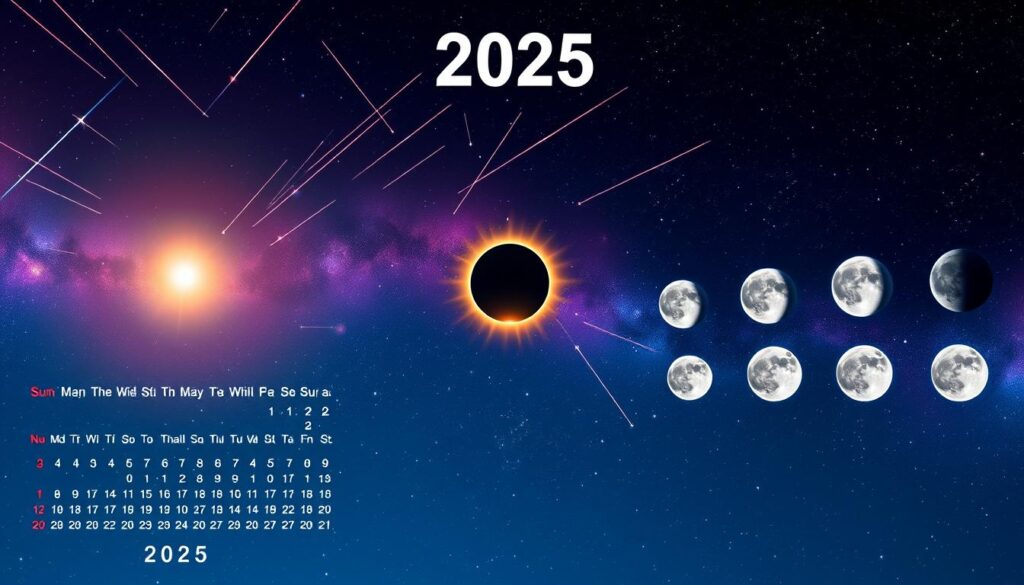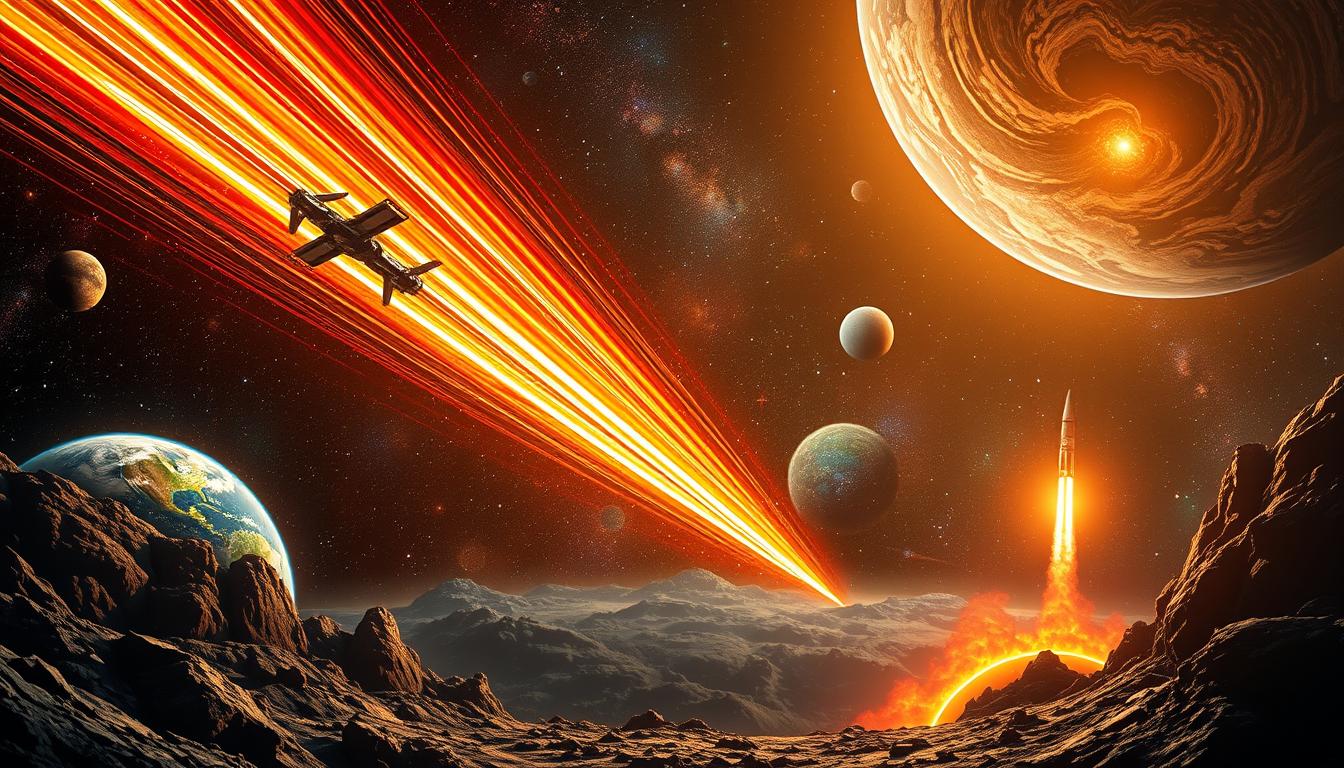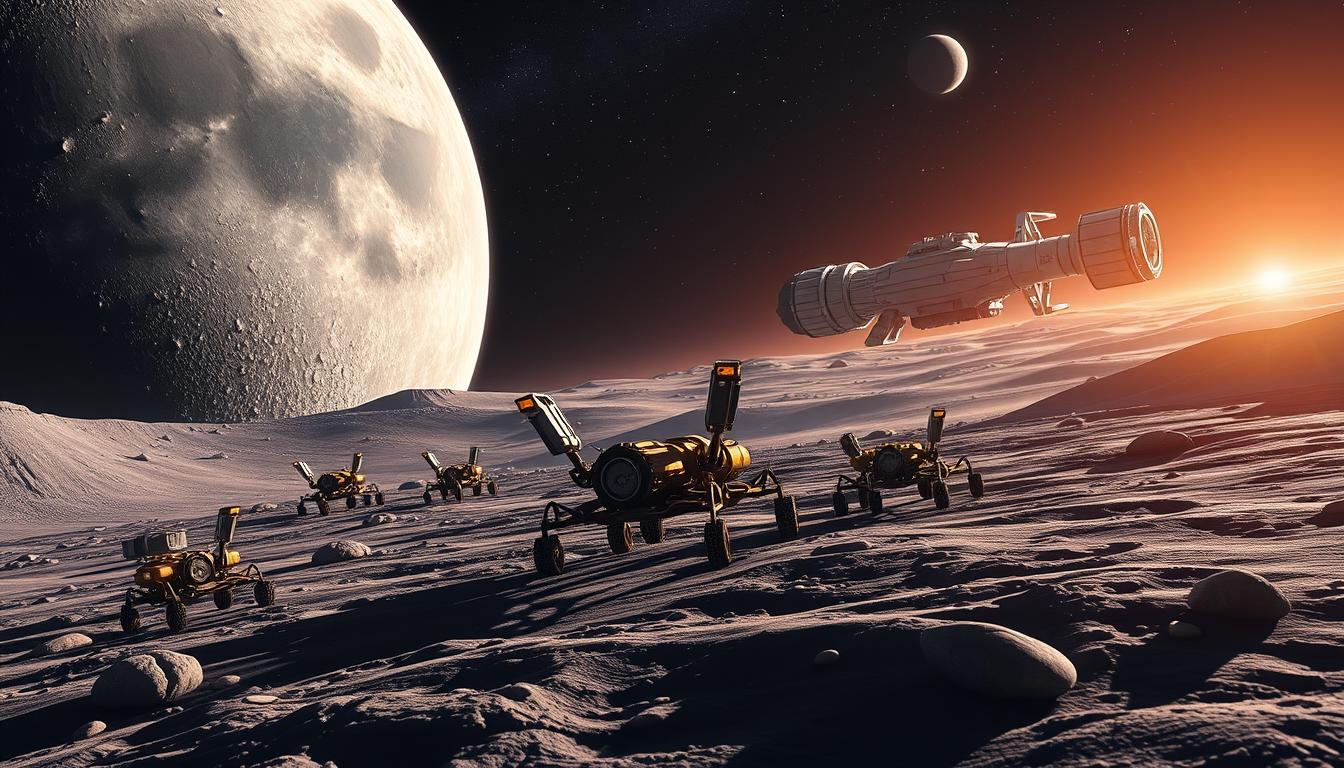Looking ahead to 2025, space is full of exciting sights and milestones. The year after 2024, with its total solar eclipse, will bring more amazing events. We’ll see 12 full Moons, many meteor showers, and four eclipses.
Space technology will also advance, helping us watch the skies. This article will cover the top space events in 2025. You’ll learn about big celestial events, NASA’s missions, and private company projects. Get ready to look up! Here’s what’s coming in 2025 and the wonders of our solar system.
Key Takeaways
- 2025 will feature 12 full Moons and multiple meteor showers.
- Prominent celestial events include two total lunar eclipses and a partial solar eclipse.
- Space technology advancements include missions like the Blue Ghost Mission and Europa Clipper.
- Notable meteor showers include the Quadrantids, Lyrids, and Geminids.
- Planetary alignments will be visible, making it easier for enthusiasts to spot celestial bodies.
- The three Supermoons will occur consecutively starting in October 2025.
Overview of Notable Space Events in 2025
The year 2025 is going to be amazing with lots of space events. We’ll see meteor showers and eclipses. The Quadrantid meteor shower will start the year, happening on January 3 and 4.
This will be a great start to the year’s sky shows.
A big total lunar eclipse, called the Worm Moon, will happen on March 14. It will be seen in North and South America, and parts of Europe, Africa, and New Zealand. People will gather to see this amazing event.
Then, on March 29, there will be a partial solar eclipse. This gives us another chance to see the beauty of our solar system.
In April, the Lyrid meteor shower will peak. It will happen on April 22 and 23. This is perfect for catching shooting stars.
August will bring the Perseid meteor shower on August 12 and 13. It will be one of the brightest meteor displays of the year.
In September, there will be another total lunar eclipse. It will happen on the 7th and 8th. It will be seen in Europe and Africa.
The Draconid meteor shower will peak on October 8/9. The Orionid meteor shower will also be a big show on October 21-22. The sky will be dark, making it perfect for watching.
2025 will also see big space missions. There will be 300 orbital launches, including ones by SpaceX and the ESA. This shows our drive to explore and understand the universe.
This year will be full of amazing events. It’s a great time for anyone who loves watching the sky.
| Event | Date | Visibility |
|---|---|---|
| Quadrantid Meteor Shower | January 3-4 | North Hemisphere |
| Total Lunar Eclipse (Worm Moon) | March 14 | Americas, parts of Europe, Africa, New Zealand |
| Partial Solar Eclipse | March 29 | Europe, northeastern North America |
| Lyrid Meteor Shower | April 22-23 | All visible regions |
| Perseid Meteor Shower | August 12-13 | All visible regions |
| Total Lunar Eclipse | September 7-8 | Europe, Africa, Asia, Australia, New Zealand |
| Orionid Meteor Shower | October 21-22 | All visible regions |
Astronomical Highlights: Major Celestial Events
The sky in 2025 will show amazing celestial events. These are for astronomers and anyone who loves the stars. You’ll see a great meteor showers schedule, cool eclipses, and beautiful full moons and supermoons 2025. Every month, there’s something new to see in the sky.
Meteor Showers Schedule
Many meteor showers will light up the sky in 2025. The Quadrantids will shine on January 2-3, a great start to the year. The Lyrids will dazzle on April 21-22, with 20 meteors per hour.
The famous Perseids will peak on August 12-13. They might show up to 100 meteors per hour, even with a full moon. The year ends with the Geminids on December 13-14. They will be easy to see because of the moon.
Eclipse Dates and Visibility
2025 will have big eclipses that everyone will want to see. A total lunar eclipse will be seen in North America on March 13-14. A partial solar eclipse will happen on March 29, best seen in Canada.
For those in Asia, Europe, and Africa, a total lunar eclipse will be on September 7. Lunar eclipses happen often, so we get to see them a lot.
Full Moons and Supermoons
There will be 12 full moons in 2025, with three supermoons in October, November, and December. Supermoons look bigger and brighter. The first supermoon is with the Harvest Moon.
Other supermoons will show us cool tidal effects and beauty as the year ends.

Look up! Here’s what’s to watch for in space in 2025
Space fans have a lot to look forward to in 2025. There will be amazing celestial phenomena to see. Skywatchers will be excited about big planetary alignments and beautiful auroras.
Significant Planetary Alignments
In January 2025, Mars will get very close to Earth. It will be at its closest on January 16. This will make Mars stand out in the sky.
Mars will join Venus, Jupiter, and Saturn in the sky. This will create a beautiful sight. It’s a rare chance to see our solar system’s wonders.
These planetary alignments 2025 will be a big deal for both amateur and casual astronomers.
Auroras: A Continued Cosmic Show
2025 will also see more auroras 2025. Solar Cycle 25 will bring many chances to see auroras. This is because of the solar cycle’s activity.
As the solar cycle goes down, the Northern Hemisphere might see amazing auroras. These are caused by storms from the sun. They remind us of nature’s beauty and our sun’s power.
With solar storms expected, 2025 will offer many chances to see auroras in the sky.
https://www.youtube.com/watch?v=xCheVIEGSWw
Space Technology Advancements in 2025
As we get closer to 2025, space technology is making big leaps. These changes will change how we see the universe. New missions are coming, thanks to teamwork between governments and private companies.
New Spacecraft and Missions Launching
Many exciting projects are ready to blast off. They show what space technology advancements 2025 has in store. NASA’s SPHEREx will look at over 450 million galaxies in February.
Japan’s M2/Resilience mission will send a lunar lander and micro-rover to the moon. They will check the moon’s soil and look for water. The European Space Agency (ESA) is also working on a Space Rider spaceplane for a test flight later this year.
Private Sector Innovations in Space Exploration
The private sector is playing a big role in private space exploration. Companies like SpaceX and Blue Origin are getting ready for new missions. SpaceX is planning its seventh Starship test launch, aiming to make rockets reusable.
SpaceX is also adding more internet satellites with Starlink. This shows how tech and space exploration are coming together. Sierra Space’s Dream Chaser will also launch to the International Space Station, showing the importance of partnerships in space.
Satellite Launches and Their Impact on Space Exploration
2025 is going to be a big year for satellites. They will help us explore space and connect to the internet better. NASA and other companies are launching satellites to reach global goals.
Key Missions from NASA and Private Companies
NASA is leading in space exploration with many missions in 2025. They will use satellites to collect data and improve communication. This is very important for science and talking to each other from far away.
- NASA will launch the SpaceX Crew-10 for long-duration missions aboard the International Space Station.
- Firefly Aerospace’s Blue Ghost Mission One aims to deliver 10 science instruments to the Moon, showcasing NASA’s renewed lunar exploration efforts.
- With plans for multiple Falcon 9 launches, SpaceX continues its role as a major player in satellite deployment, including Starlink internet services.
- Blue Origin’s New Glenn rocket is also set to debut, demonstrating innovations in satellite technology.
Future of Internet Satellites: Project Kuiper
Amazon’s Project Kuiper is a big deal in 2025. It wants to put many satellites in space to bring the internet to more places. This is a big challenge to SpaceX’s Starlink.
Project Kuiper wants to give fast internet to places that don’t have it. This will help schools and businesses all over the world. Amazon is working hard to make the internet available to everyone.
| Company | Mission | Launch Vehicle | Target Date |
|---|---|---|---|
| NASA | SpaceX Crew-10 | Falcon 9 | February 2025 |
| Firefly Aerospace | Blue Ghost Mission One | Falcon 9 | 2025 |
| SpaceX | Starlink Satellite Launch | Falcon 9 | 2025 |
| Blue Origin | New Glenn Rocket Launch | New Glenn | January 2025 |
| Amazon | Project Kuiper Satellites | Not specified | 2025 |
Satellite launches in 2025 will change how we use technology and explore space. Both governments and private companies are working hard to make this happen.
Upcoming Space Missions to Explore the Moon and Beyond
2025 is a big year for space travel. We will see new lunar landers and missions to other planets. These will help us learn more about the Moon and other worlds.
Projects like the Blue Ghost mission are very exciting. They show how far we can go in space. We’re getting closer to knowing our neighbors in the universe.
New Lunar Landers: Blue Ghost Mission and More
Lunar landers are key for exploring the Moon again. The Blue Ghost mission will help us understand the Moon’s geology. It will also show if we can use the Moon’s resources.
The Resilience mission will also be important. It will try to get water, oxygen, and hydrogen from the Moon. These missions will help us live better in space, with help from NASA and private companies.
Continuing Missions to Jupiter’s Moon, Europa
The Europa Clipper mission is very exciting. It will study Europa, Jupiter’s moon, to see if it has life. This mission will help us learn more about the outer solar system.
As Europe gets ready to fly by Mars in March 2025, we’re all excited. We can’t wait to see what new discoveries it will make.
Conclusion
The year 2025 is going to be big for space. We’ll see many cool 2025 space events overview and space missions. These will excite people all over the world.
Highlights include the Quadrantids meteor showers on January 3. There will also be a total lunar eclipse on March 14. And, we’ll see supermoons in late 2025.
Space missions like the Blue Ghost Mission will teach us more. The Proba-3 spacecraft will also help us learn. Europa Clipper’s trip to Jupiter will give us new insights.
We’ll also see amazing planetary alignments and auroras. These will show us the beauty of space. It’s all part of the future of space exploration.
2025 is the start of a new era of discovery. It will mix nature’s wonders with new tech. This will make us wonder about our universe all over again.


